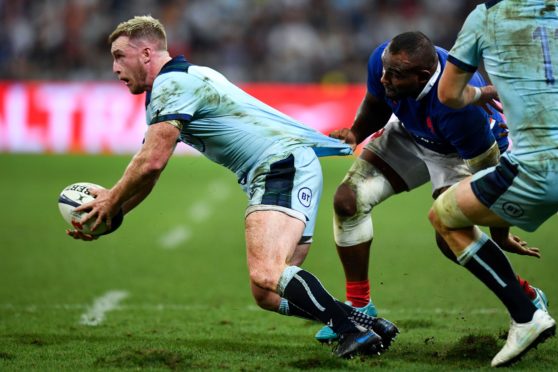Yes, it was a warm-up. Yes, it was the first real hit-out. Yes, the team on the field could reasonably be said to contain all of the nine players in the squad who won’t even get on the flight to Japan.
But you can call up all the caveats available, and you still can’t remotely disregard the paucity of performance from Scotland in the 32-3 hammering in Nice on Saturday night.
First of all, this sits squarely in a trend of Scotland performances in this World Cup cycle of 2016 to 2019 when the team looked under-prepared, rudderless and often clueless. Remember Twickenham in 2017, Fiji in Suva later that same year, or Cardiff in 2018, and Paris earlier this year.
Or indeed the first half in Twickenham this year. One hoped, reasonably, that the cathartic nature of that comeback against England had finally extinguished these occasional mental frailties away from Murrayfield that Scotland seem to be vulnerable to.
Not a bit; nine of the starting team on Saturday night also played in the Calcutta Cup game.
The second reason for concern is that we’ve been constantly told in press conference after press conference this summer that every player in the squad is at a career peak of condition.
Records have tumbled in speed, fitness and strength tests across the board, we’re assured. The preparation carefully curated by Gregor Townsend over many months should have delivered the squad running at full tilt almost from the off.
Furthermore, we’ve been assured in the last few weeks that the players couldn’t wait to get out there and work off frustrations of not playing in actual games.
Now, we can again be reasonable and agree that the absolute peak of performance and condition should not be reached until Ireland in Yokohama on September 22. Only on Saturday night’s evidence the distance between their present level of performance and that required to beat Ireland is enormous.
The third reason for concern is that the tactical preparation and execution on Saturday was so off – miles off – that it offers actual alarm for Scotland, in that opening game and beyond the pool stages, should they even get that far.
Again, Scotland showed they don’t have much of a secondary plan if faced with a bigger pack that successfully arm-wrestles them to the deck.
The Scottish pack – mostly Edinburgh players who looked as if they needed a replenishing dose of Richard Cockerill ranting – gained just 22 metres carrying in the first half. Adam Hastings had a difficult evening, but Dan Carter would have struggled behind that kind of go-forward, much less Finn Russell.
In that respect it’s difficult to blame the three-quarters much for the performance, given what scant attacking ball they were given. Even their missed tackles – six by Hastings, three by Darcy Graham, two by Huw Jones – were at least partly due to having free-running French forwards careering down their channels at full pace, unfettered by physical contact.
Stuart Hogg did as much as he could, Duncan Taylor made at least two try-saving tackles on his mercifully knock-free return. Rory Hutchinson’s half-hour cameo was probably the biggest plus point of the night, and he seems to have a real chance of going to Japan.
Upfront, John Barclay and Jamie Ritchie seemed like the sole forms of resistance to France’s bigger, faster forwards. Whether the French looked that good or were just made to look it by the Scottish pack we probably won’t know even after the return match this week – they’ve really only looked that good against Scotland this year, and in two matches now.
That return game at Murrayfield on Saturday takes on huge importance now. Scotland simply have to show something to back up the fabulous tales of the unparalled preparation we’ve been told about, or panic really will set in.
The old days of Vern Cotter taking them up the mountains to chase rabbits in a boot camp, at the moment, looks a better scheme than Gregor’s more scientific, touchy-feely approach.
